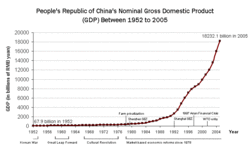I finished my last post with the last paragraph of the Wikipedia on the issue China economic reforms. Reasons for success might be considered many, but I would like to consider the most important reason of all; the right disposition of the Chinese government to achieve it, and this is to put on top of all priorities economic development. It might sound quite logical, but reality is that it is not such an easy task because political issues usually become priorities and disturb and break such an approach to the matter.
In this regard we have to turn our eyes to Chinese politics under Deng Xiaoping. Unless Mao Zedong´s time when China got involved in at least six wars and terrible disturbances inside, Deng Xiaoping policy was expressed, also in Western terms, as a policy of stability –if not directly called of peace.
Stability has been the key word all along the three generations of leaders since Deng Xiaoping in order to let the economy flourish. Even if they have kept a political issue under the consideration of indisputable; China sovereignty on Taiwan, they have played it in a pragmatic manner and, as they did with Hong Kong, the game goes about an always growing economic involvement and entanglement.
China domestic political doctrine has been firmly exposed as such; stability and stability to allow economic development. People’s rights and democracy have not been allowed to put into question, as they are not considered a priority, in order not to disturb economic development and, especially after the Tiananmen revolts, people in China has accepted the Chinese Communist government deal. Even some measures taken by the leadership, especially by the current one, against a too fast path of devolopment have to be read in attention to the country stability.
Especially interesting has been how China has put this policy into practice in the international arena. In contrast with the XX century when Western power allied to submit China, this time China has been able to play with the interests of them separately and when the US has tried to play hard with China, it has quickly understood that his economic involvement with China, as also his allies’ involvement with the communist country would bring any pressure on China to a failure and would result in economic losses, something the American system is not prepared to assume easily.
But the reality is that China has practiced a real pacifist policy and most of China researchers as Enrique Fanjul, myself or others in Spain and I guess in other countries, people who has really had a vital relationship with China, has noticed and transmitted this commitment of China with international peace.
The West has foreseen long ago the China rise and has tried to avoid it, therefore some other more neutral sources, many not personally involved with China, have tried to design a policy able to contain it. But China has been able to defuse any of those attempts putting in place pragmatism and that pacifist or pacific approach.
Finally, the last reason for success pointed out by the Wikipedia, I did not copy in my previous post is:
“Herman Kahn explained the Reasons for success rise of Asian economic power saying the Confucian ethic was playing a "similar but more spectacular role in the modernization of East Asia than the Protestant ethic played in Europe".
Under my understanding he does not hit the point, but get quite close to it. But we will see it when we go back to this point from the Chinese point of view, as we go now to a new part in the blog titled Chinese Thinking.




